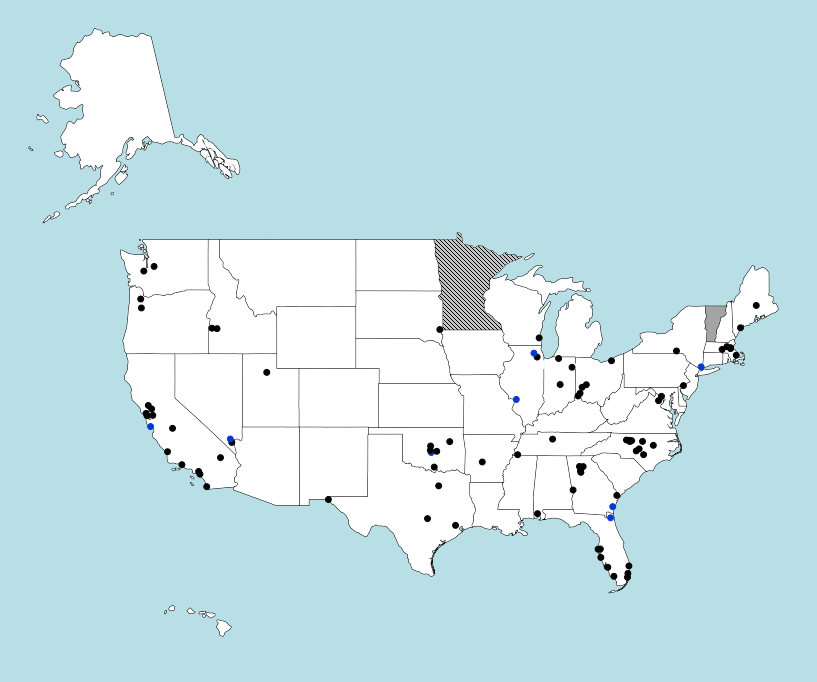In 2013, NIJ began collecting information through the Latent Fingerprint Interoperability Survey (LFIOS). LFIOS is the only comprehensive effort to measure the level of interoperability of automated fingerprint identification systems (AFIS) maintained by state and local law enforcement agencies for the electronic exchange of latent fingerprint data to support criminal investigations.[1]
The survey was designed to help law enforcement, government administrators, legislators and researchers understand the technological and regulatory barriers affecting automated, cross-jurisdictional interoperability.
About the Survey
NIJ developed the survey during 2011 and 2012 in coordination with the Latent Print AFIS Interoperability Task Force chartered by the Subcommittee on Forensic Science under the National Science and Technology Council.
The LFIOS collected critical data in several areas:
- The types and functions of fielded AFIS systems in state and local agencies
- The current policy agreements among jurisdictions to permit the sharing, exchange and searching of latent fingerprints electronically
- The technological and regulatory factors that affect electronic sharing, exchange and searching of latent fingerprints across various jurisdictions
NIJ sent the survey to law enforcement agencies with an AFIS in 51 state jurisdictions (all 50 states and the District of Columbia) and over 100 local jurisdictions identified as having an AFIS.
Each participating agency responded to core questions on topics including AFIS vendor information, tenprint and palm print records, latent records, and searching characteristics. State agencies responded to additional questions geared to state agencies while local agencies responded to questions geared to local agencies.
The data collection period lasted from January 2013 to January 2014. At the conclusion of data collection, 48 state agencies responded fully with one state partially responding with some information. Of the local agencies, 78 responded fully with eight partially responding.
Survey Results
A summary report of the content and process of developing and fielding the data collection instrument was released in August 2014. This report does not provide any particular findings or specific recommendations related to fingerprint database interoperability. It is intended to accelerate the availability of the survey results and data to the forensics community.
The summary report lists every question of the data collection instrument with the aggregate results for each without any agency-specific identifiers associated with the data.
Download and read:
- The report, Latent Fingerprint Interoperability Survey: Summary Reporting of Data (pdf, 195 pages).
- The Core Questionnaire (pdf, 79 pages).
- The Local Addendum (pdf, 19 pages).
- The State Addendum (pdf, 18 pages).
NIJ anticipates that the data set associated with LFIOS will be publicly available on the National Archive of Criminal Justice Data in 2015.
Any state or local law enforcement agency with an AFIS that has not responded to the survey but would like to should contact Mark Greene at [email protected] for more information.
Motivation for the Survey
The survey was motivated in part by the need identified in the 2009 National Research Council report, Strengthening Forensic Science in the United States: A Path Forward:
"Great improvement is possible with respect to AFIS interoperability. Many crimes no doubt go unsolved today simply because investigating agencies cannot search across all the individual databases that might hold a suspect's fingerprints or contain a match for an unidentified latent print from a crime scene. It is possible that some perpetrators have gone free because of the limitations on fingerprint searches."[2]
The report noted several nontechnology challenges to achieving interoperability:
- Convincing federal and state policymakers to mandate nationwide AFIS interoperability
- Persuading AFIS equipment vendors to cooperate and collaborate with the law enforcement community and researchers to create and use baseline standards for sharing fingerprint image and minutiae data and interfaces that support all searches
- Providing law enforcement agencies with the resources necessary to develop interoperable AFIS implementations
- Coordinating jurisdictional agreements and public policies that would allow law enforcement agencies to share fingerprint data more broadly
To make effective use of resources, especially in a fiscal climate of constrained budgets, governments must have access to basic quantitative information on a national scale to gain a deeper understanding of the current situation before making tactical decisions regarding where and how to improve interoperability.


